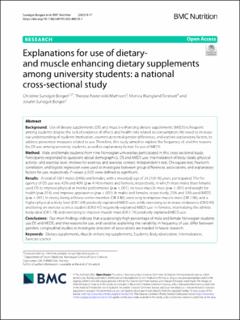| dc.contributor.author | Sundgot-Borgen, Christine | |
| dc.contributor.author | Mathisen, Therese Fostervold | |
| dc.contributor.author | Torstveit, Monica Klungland | |
| dc.contributor.author | Sundgot-Borgen, Jorunn | |
| dc.date.accessioned | 2022-12-01T09:38:27Z | |
| dc.date.available | 2022-12-01T09:38:27Z | |
| dc.date.created | 2022-02-14T09:51:24Z | |
| dc.date.issued | 2022 | |
| dc.identifier.citation | BMC Nutrition. 2022, 8(2022), Artikkel 17. | en_US |
| dc.identifier.issn | 2055-0928 | |
| dc.identifier.uri | https://hdl.handle.net/11250/3035242 | |
| dc.description | This article is licensed under a Creative Commons Attribution 4.0 International License, which permits use, sharing, adaptation, distribution and reproduction in any medium or format, as long as you give appropriate credit to the original author(s) and the source, provide a link to the Creative Commons licence, and indicate if changes were made. The images or other third party material in this article are included in the article's Creative Commons licence, unless indicated otherwise in a credit line to the material. If material is not included in the article's Creative Commons licence and your intended use is not permitted by statutory regulation or exceeds the permitted use, you will need to obtain permission directly from the copyright holder. | en_US |
| dc.description.abstract | Background: Use of dietary supplements (DS) and muscle enhancing dietary supplements (MEDS) is frequent among students despite the lack of evidence of effects and health risks related to consumption. We need to increase our understanding of students’ motivation, examine potential gender differences, and explore explanatory factors, to address preventive measures related to use. Therefore, this study aimed to explore the frequency of, and the reasons for, DS use among university students, as well as explanatory factors for use of MEDS.
Method: Male and female students from nine Norwegian universities participated in this cross-sectional study. Participants responded to questions about demographics, DS and MEDS use, internalization of body ideals, physical activity- and exercise level, motives for exercise, and exercise context. Independent t-test, Chi-square test, Pearson’s correlation, and logistic regression were used to investigate between group differences, associations, and explanatory factors for use, respectively. P-values ≤ 0.05 were defined as significant.
Results: A total of 1001 males (34%) and females, with a mean(sd) age of 24.21(4.76) years, participated. The frequency of DS use was 42% and 40% (p = .414) in males and females, respectively, in which more males than females used DS to improve physical or mental performance (p = < .001), increase muscle mass (p = < .001) and weight for health (p = .014), and improve appearance (p = < .001). In males and females, respectively, 25% and 10% used MEDS (p = < .001). In males, being a fitness center member (OR:3.80), exercising to improve muscle mass (OR:1.96), and a higher physical activity level (OR:1.09) positively explained MEDS use, while exercising to increase endurance (OR:0.49) and being an exercise science student (OR:0.47) negatively explained MEDS use. In females, internalizing the athletic body ideal (OR:1.78) and exercising to improve muscle mass (OR:1.74) positively explained MEDS use.
Conclusions: Our main findings indicate that a surprisingly high percentage of male and female Norwegian students use DS and MEDS, and that reasons for use, and variables explaining the variability in frequency of use, differ between genders. Longitudinal studies to investigate direction of associations are needed in future research. | en_US |
| dc.language.iso | eng | en_US |
| dc.subject | body idealization | en_US |
| dc.subject | dietary supplements | en_US |
| dc.subject | exercise science | en_US |
| dc.subject | internalization | en_US |
| dc.subject | muscle enhancing supplements | en_US |
| dc.subject | students | en_US |
| dc.title | Explanations for use of dietary- and muscle enhancing dietary supplements among university students: A national cross-sectional study | en_US |
| dc.type | Peer reviewed | en_US |
| dc.type | Journal article | en_US |
| dc.description.version | publishedVersion | en_US |
| dc.rights.holder | © The Author(s) 2022 | en_US |
| dc.source.pagenumber | 10 | en_US |
| dc.source.volume | 8 | en_US |
| dc.source.journal | BMC Nutrition | en_US |
| dc.identifier.doi | 10.1186/s40795-022-00510-1 | |
| dc.identifier.cristin | 2001154 | |
| dc.description.localcode | Institutt for idrettsmedisinske fag / Department of Sports Medicine | en_US |
| dc.source.articlenumber | 17 | en_US |
| cristin.ispublished | true | |
| cristin.fulltext | original | |
| cristin.qualitycode | 1 | |
